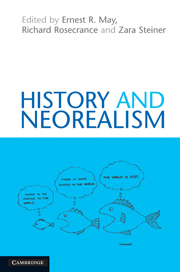Book contents
- Frontmatter
- Contents
- List of tables
- Notes on contributors
- Acknowledgments
- 1 Theory and international history
- 2 Transformations in power
- 3 Domestically driven deviations: internal regimes, leaders, and realism's power line
- 4 How international institutions affect outcomes
- 5 Not even for the seventeenth and eighteenth centuries: power and order in the early modern era
- 6 Austria-Hungary and the coming of the First World War
- 7 British decisions for peace and war 1938–1939: the rise and fall of realism
- 8 Realism and risk in 1938: German foreign policy and the Munich Crisis
- 9 Domestic politics, interservice impasse, and Japan's decisions for war
- 10 Military audacity: Mao Zedong, Liu Shaoqi, and China's adventure in Korea
- 11 The United States' underuse of military power
- 12 The overuse of American power
- 13 Redrawing the Soviet power line: Gorbachev and the end of the Cold War
- 14 Shared sovereignty in the European Union: Germany's economic governance
- 15 John Mearsheimer's “elementary geometry of power”: Euclidean moment or an intellectual blind alley?
- 16 History and neorealism reconsidered
- Index
- References
12 - The overuse of American power
Published online by Cambridge University Press: 05 June 2012
- Frontmatter
- Contents
- List of tables
- Notes on contributors
- Acknowledgments
- 1 Theory and international history
- 2 Transformations in power
- 3 Domestically driven deviations: internal regimes, leaders, and realism's power line
- 4 How international institutions affect outcomes
- 5 Not even for the seventeenth and eighteenth centuries: power and order in the early modern era
- 6 Austria-Hungary and the coming of the First World War
- 7 British decisions for peace and war 1938–1939: the rise and fall of realism
- 8 Realism and risk in 1938: German foreign policy and the Munich Crisis
- 9 Domestic politics, interservice impasse, and Japan's decisions for war
- 10 Military audacity: Mao Zedong, Liu Shaoqi, and China's adventure in Korea
- 11 The United States' underuse of military power
- 12 The overuse of American power
- 13 Redrawing the Soviet power line: Gorbachev and the end of the Cold War
- 14 Shared sovereignty in the European Union: Germany's economic governance
- 15 John Mearsheimer's “elementary geometry of power”: Euclidean moment or an intellectual blind alley?
- 16 History and neorealism reconsidered
- Index
- References
Summary
The end of the Cold War and the demise of the Soviet Union left the United States the sole remaining superpower and inaugurated an era of American primacy. America's global dominance prompted popular references to a latter-day Roman Empire. Transcending the Cold War rubric of “superpower,” “hyperpower” entered the political lexicon to convey the magnitude of the United States' paramount international status. Scholars described the international system as “unipolar” and debated whether such a structure would be stable or not. As US defense spending approximates that of all other countries in the world combined, the international system remains unipolar, with respect to that single military dimension of hard power. But that unprecedented power did not translate into security for America. The mass-casualty attacks by Osama bin Laden's Al Qaeda network on 9/11 ushered in a new age of American vulnerability more dangerously unpredictable than the Cold War.
On the morning after the September 11, 2001 terrorist attacks on New York and Washington, international solidarity with the United States was dramatically conveyed in the Le Monde headline, “Nous sommes tous Américains!” That sentiment, however, soon eroded when the Bush administration pressed to extend the “global war on terrorism” from Al Qaeda's stronghold in Afghanistan into Iraq, an action that France, Germany, Russia, and others regarded as an ill-advised “war of choice.” Five years after 9/11, a plurality of West Europeans, according to a public-opinion poll, judged the United States to be “the greatest threat to global stability.”
- Type
- Chapter
- Information
- History and Neorealism , pp. 246 - 266Publisher: Cambridge University PressPrint publication year: 2010



